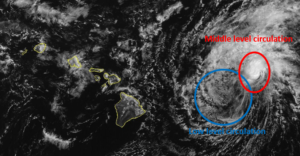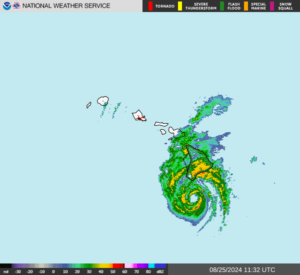Tropical Storm Henriette was passing northeast of Hawaii on Sunday. At 5:00 a.m. EDT on Sunday the center of Tropical Storm Henriette was located at latitude 23.8°N and longitude 150.3°W which put the center about 420 miles (675 km) northeast Hilo, Hawaii. Henriette was moving toward the northwest at 15 m.p.h. (24 km/h). The maximum sustained wind speed was 40 m.p.h. (65 km/h) and there were wind gusts to 50 m.p.h. (80 km/h). The minimum surface pressure was 1006 mb.
Former Tropical Storm Henriette strengthened back to a tropical storm as it moved northeast of Hawaii on Sunday. More thunderstorms former near the center of Henriette’s circulation. The inner end of a rainband wrapped much of the way around the center of Tropical Storm Henriette. A clear area was forming at the center of Henriette. Storms near the center of Henriette generated upper level divergence that pumped mass away from the tropical storm.
The circulation around Tropical Storm Henriette was small. Winds to tropical storm force extended out 105 miles (165 km) from the center of Henriette’s circulation.
Tropical Storm Henriette will move through an environment favorable for intensification during the next 24 hours. Henriette will move over water where the Sea Surface Temperatures are near 26°C. It will move under the middle of an upper level trough that is east of Hawaii. The upper level winds are weak near the middle of the trough and there will be little vertical wind shear. Tropical Storm Henriette will intensify during the next 24 hours.
Tropical Storm Henriette will move around the southwestern part of a high pressure system over the Eastern North Pacific Ocean. The high pressure system will steer Henriette toward the northwest during the next 24 hours. On its anticipated track, Tropical Storm Henriette will pass well to the north of Hawaii.
Elsewhere, Tropical Storm Ivo was weakening southwest of Baja California. At 5:00 a.m. EDT on Sunday the center of Tropical Storm Ivo was located at latitude 21.5°N and longitude 114.9°W which put the center about 335 miles (535 km) west-southwest of the southern tip of Baja California. Ivo was moving toward the west-northwest at 8 m.p.h. (13 km/h). The maximum sustained wind speed was 40 m.p.h. (65 km/h) and there were wind gusts to 50 m.p.h. (80 km/h). The minimum surface pressure was 1006 mb.


